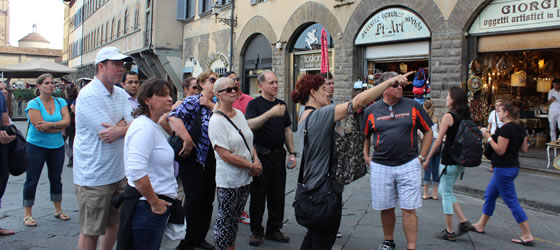Italy Day V: High-Tech Healthcare Near Pisa

The final day of TRSA’s tour of textile service plants in Northern Italy offered the group’s 30 attendees a look at the future of healthcare processing at the So.Ge.Si. Ponsacco plant outside Pisa. This plant featured a number of high-tech systems for enhancing efficiency and quality in healthcare.
Leading the tour was Alessandro Rolli, the managing director of Kannegiesser Italy, who also acted as interpreter for the plant manager. The tour began with an overview of the plant’s wastewater treatment and water-recycling system, an initiative that enables the plant to recycle 70% of its water, which is drawn from local wells. “They are filtering the water to make it usable for washing,” said Rolli, pointing to a large open-air tank of grayish wastewater from the plant’s wash aisle. Oxygen and bacteria as well as special filtering equipment are used to purify the water for reuse, said Rolli. Bubbles gurgling in the mass of water showed the injection of air in the cleaning process. Sludge from the water is skimmed off and removed in compliance with local regulations, he added.
Water conservation is not only good for the environment, it’s an economic necessity here. “Water in Italy is not as expensive as Germany, but the cost is increasing,” said Rolli, noting that the water in this country costs about €1-2 per thousand liters, vs. €5-10 in Germany. “If you treat the water yourself, you pay less.” The plant processes 160,000 liters of wastewater per day, he said.
Moving inside the nearly 81,000-square-foot plant, we see a full separation of clean and soil areas with a wall placed between the two sides of the plant. “This is becoming a popular demand from hospitals,” Rolli said. Nearby are two 300 lb. Kannegiesser washer/extractors used mainly for healthcare garments. Some of these goods are fitted with radio frequency identification chips, and others have barcodes. It varies, depending on the account, Rolli said. These machines and also a cart washer are built into the wall so that clean goods and carts can be taken to the clean side with no risk of contamination from the soil area of the plant. Other equipment includes a Kannegiesser PowerTrans tunnel washer with 16, 185 lb. compartments that processes mainly sheets and terry towels. The plant also has a reconditioned Pellerin Milnor Corp. tunnel as well that’s used to process healthcare garments. “Cakes” of clean wet goods move by conveyor to one of four, 187 lb. Kannegiesser dryers. The plant has a chemical injection system from the Textile Care Division of Ecolab.
Like many of the plants seen on this tour, the So.Ge.Si. Ponsacco facility has automated sheet feeding equipment. Employees clip the sheets to equipment that leads to the rail system, and they line up near the ceiling for automatic processing in one of four ironers. Sheets move along the rail system with a clickety-clack sound. The plant’s 36 production employees process 35,273 lbs. per shift, and sheets move at a rate of 114 feet per minute on the finishing side.
Two of the plant’s ironers also are equipped with special cameras from Kannegiesser that automatically detect tears or stains and reject the sheets for repair or rewash before they go to the customer. The plant has an extensive suction system that moves operating room textiles from the dryers to finishing. We watched as an employee with a cart full of goods fed textiles into the tube for additional processing.
To help save energy and improve efficiency, Rolli noted that rather than using a conventional boiler, the plant employs a small steam generator that’s used to bring water in the tunnels and washer/extractors up to the proper temperature. This “less steam” system is sufficient to power the wash aisle because other equipment, such as the ironers, a tunnel finisher and several pieces of pressing equipment are heated using natural gas.
An unusual feature in this plant is the fact that it’s also equipped to process medical instruments as well as textiles. Housed in a separate section of the plant, this department includes a series of five machines for sorting, washing and sterilizing medical instruments. The plant also has a special washer/extractor that’s used to launder mattresses—a service that’s increasingly in demand due to the need to ensure infection control in hospitals. A special chamber similar to an autoclave is used to sterilize foam pillows and mattresses by placing them in a vacuum environment for nine minutes at a temperature of 105° C.
Following the tour, attendees boarded a bus for the hour drive back to Florence. Upon their return, they reassembled for a two-hour walking tour of this historic city. Sylvia, a Florentine native who served as tour guide, walked the group past a series of historic churches and palaces such as the Duomo, or Basilica di Santa Maria del Fiore completed in 1436, to the 16th century offices of Cosimo de Medici that now house the world-renowned Uffizi gallery of fine art. Other sites included an open-air sculpture area featuring original works, including the Rape of the Sabine Women, Perseus with the Head of Medusa and other works based on Greek mythology. The guide added contemporary references to her commentary, including a 1966 flood that devastated the city and the fact that retreating German forces near the end of World War II spared the famous Ponte Vecchio bridge over the River Arno as allied forces advanced on the city.
An hour or so after the tour, the TRSA group came together once more for a final sendoff in the form of a dinner at Ristorante Antico Fattore sponsored by Kannegiesser.
